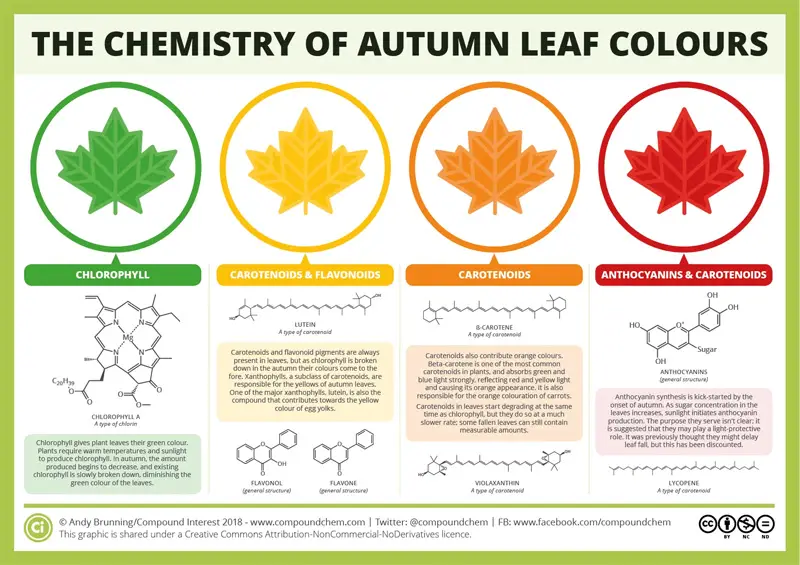When summer is over, leaves start changing from green to red, orange, yellow, and brown. Do you wonder why? Here’s help to understand why leaves change colors.
Why Leaves are Green
Table of Contents
There are three sorts of pigments in leaves. Pigments are like watercolors. The pigments in leaves are Chlorophyll, Carotenoids, and Anthocyanins.
Anthocyanins are the pigments that give us the color in brightly colored foods like cherries and blueberries. The anthocyanins stay in the liquid part of the leaf.
Carotenoids are the pigments that give us the yellow, orange, and brown colors we see in favorite foods like bananas, corn, and carrots. Carotenoids live in chloroplasts.
Chlorophyll is the pigment that gives leaves their green color. Chlorophyll is very important for plants. It helps plants to use the sun to make their food. Chlorophyll makes food for plants using a process called photosynthesis. Chlorophyll stays in chloroplasts too.
During the spring and summer, there is more daylight and the leaves are busy making food for the tree. Because the chlorophyll is used to make food there is a lot of it in the chloroplasts during the summer and so the color green covers up the other pigments or colors in the leaves.
Why Leaves Change Color
Leaves change color when the days get shorter. When the days get shorter, there is less sunlight.

As summer ends and we start to move towards fall, the days start getting shorter. With shorter days, the leaves can’t make as much food and the chlorophyll begins to disappear. So in the fall, we start seeing the other colors in the leaf that the chlorophyll was blocking.
Does the Weather Change the Colors?
The weather does not make the tree leaves change color. But it can make the colors uglier or prettier.
If the temperature is too hot or too cold, the leaves are not as bright. If the days are sunny and warm but the nights are cool without being too cold the colors are brighter. They are brighter because the sun lets the plants keep making sugar, which helps the color. The cold nights keep the sugar from moving out of the leaf and into the tree so the color stays strong. If it freezes the leaves are killed and the colors fade faster.
How much water the tree gets makes a difference too. If the trees get too little water, the leaves die faster and fall to the ground. If there is lots of rain, there isn’t as much sunlight and the leaves don’t turn as bright.
Why do Leaves Fall off the Tree?
Leaves are not strong and cannot last through the winter. So the tree gets rid of its leaves.
The tree knows that winter is coming when the days get shorter and there is less light. When the days get shorter, the tree cuts of the veins that carry food into and out of the leaves. It cuts off the veins by layering cells at the place where the leaf connects to the branch, sort of like a cork. When the layer of cells is complete, the leaf can’t hold onto the tree anymore and falls off.
Activity: Painting on Dried Leaves
How to paint on a leaf.
A sycamore tree leaf is a wonder for size and when soaked in water makes a nice leathery surface for artwork.
When I was a child I learned the Zaccheaus in a sycamore tree song at Sunday school. I thought the sycamore was exclusively a Holy Land tree. How happy I was to find they are a common American tree!
Sycamore trees are a tall straight tree that has not had the space to spread out its limbs but is nonetheless one of our favorite trees. The leaves are huge and the gray bark peels back on itself like birch bark, leaving a smooth white trunk. The tree makes great shade on my porch with its big leaves and the balls of seeds it produces are a curiosity, without the prickly spines of the Sweetgum balls.
These leaves can be used as art paper. Have the students pull the leaves with their stems in the fall and press them between paper, under heavy books or bricks. When the leaves are dry and flattened retrieve them and soak them in water. They will become soft and pliable like leather and the students can paint on them with acrylic paints. After painting and drying repress if necessary and consider framing. These painted leaves make lovely gifts for teachers, friends, or relatives.
Add a few of these mega leaves to your pressed collection. For more leaf art ideas see this leaf art mask article. For help recognizing the sycamore tree try a field guide of North American trees or an online listing of American trees.
